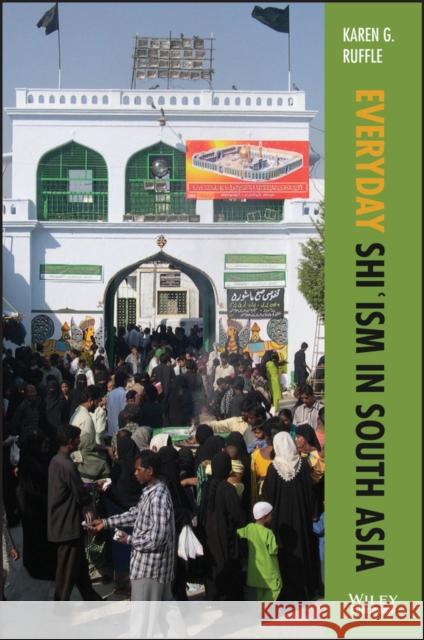Everyday Shi'ism in South Asia » książka



Everyday Shi'ism in South Asia
ISBN-13: 9781119357148 / Angielski / Miękka / 2021 / 368 str.
Everyday Shi'ism in South Asia
ISBN-13: 9781119357148 / Angielski / Miękka / 2021 / 368 str.
(netto: 175,08 VAT: 5%)
Najniższa cena z 30 dni: 182,70
ok. 30 dni roboczych
Dostawa w 2026 r.
Darmowa dostawa!
Glosariusz/słownik
Acknowledgments xiiTransliteration Note xviIntroduction 1Everyday Shi¿ism 6Center and Periphery Reconsidered 8The Hyper-visible "Invisible" Community 13Redefining Norms: Shi¿i/South Asia/Everyday 15Representing Shi¿ism 20Contributions 31The Scope of Everyday Shi¿ism 32References 34Recommended Readings 38Theoretical Lessons 381 South Asian "Lovers" of the Ahl-e Bait: Hindu and Non-Shi¿i Muslim Traditions of Devotion 39Muharram beyond Shi¿ism: The "Composite Culture" of Commemorating Karbala in South Asia 40The Husaini Brahmins: Hindu Devotees of Imam Husain 42Pirla-Panduga: "The Festival of Pirs" among Hindus and Sunnis in South India 48Devotion to Piru-Swami 51Dulha! Dulha!: Sunni and Hindu Possession Rituals for the Bridegroom Qasem 56The Shrine of Bibi Pak Daman in South Asian Muslim Cultural Memory 63Conclusion 68References 70Recommended Readings 72Theoretical Lessons 732 "Come, and Cry, Because ¿Ashura Is Today": Shi¿i Literary Aesthetics 74Tears of a Horse: Sufi Metaphors in Shi¿i Devotional Narratives of Birds and Horses 76The Female Voice and the Development of Shi¿i Devotional Literature 82A Solace for the Heart, a Source of Religious Guidance: Multiple Perspectives on the Nauhah 84'Why not Beat My Head in Lamentation?': Gender and Voice in the Nauhah 86'Karbala: Come to the Best of Deeds': The Nauhah and Normative Discourse 88Hearing the Miraculous: A Different Kind of Love Story 92Human Rights and Communal Harmony: Re-Visioning Karbala in South Asian Literary Prose 106References 109Recommended Readings 111Theoretical Lessons 1113 In the House of the Tenth: Spaces of Shi¿i Devotion 113Mosques 115Case Study-Microscopic 3.1: Toli Mosque, Hyderabad 120Case Study-Snapshot 3.2: ¿Ashurkhanah wa Masjid-e Ahl-e Bait: A Mosque-¿Ashurkhanah in Hyderabad 124In the House of the Tenth: ¿Ashurkhanahs in Southern India 130Lions, Arches, and Chains: Visual Representation andSymbolic Meaning in Shi¿i Built Spaces 135Case Study-Microscopic 3.3: Panjah Shah-e Wilayat ¿Ashurkhanah, Hyderabad 141Imambaras: Dwelling in the Court of the Imam 146Case Study-Microscopic 3.4: The Bara Imambara of Lucknow 148Karbala Grounds: Pilgrimage and Burial 151Case Study-Microscopic 3.5: Karbala Kazmain, Lucknow 157Conclusion 160References 161Recommended Readings 163Theoretical Lessons 1644 Metal Hands and Stone Footprints: Shi¿i Material Practice 165Conceptualizing Shi¿i Materiality 168Gazing in the Eyes of a Martyr: Embodiment and Presencing in the ¿Alams of Karbala Heroes 171Na3/4izah 172Bori 174Peta 174Hatheli 175Sharja 179Jibh 180Case Study-Microscopic 4.1: ¿Alam-e Sartauq, Hyderabad 182Case Study-Microscopic 4.2: The ¿Alam of Imam Husain at Dargah Hazrat ¿Abbas, Lucknow 187Ta¿ziya: Karbala on the Move in South Asia 192Ephemeral Ta¿ziya 196Permanent Ta¿ziya 197Case Study-Snapshot 4.3: Permanent Ta¿ziya: Seeing, Embodying, and Making Imam Husain Close 197Zuljanah: Remembering Karbala with Imam Husain's Loyal Horse 203Debating Devotional Representations of the Imams and Ahl-e Bait 208Conclusion 213References 214Recommended Readings 217Theoretical Lessons 2185 Every Place Is Karbala, Every Day Is ¿Ashura: South Asian Muharram Rituals 219"Hobson-Jobson": Representing Muharram in the Religious Imaginaire 221The Ten Saddest Days: The Ayyam-e ¿Aza 2231 Muharram 2253 Muharram 2274 Muharram 2287 Muharram 2298 Muharram 2319 Muharram 23410 Muharram 236¿Ashura: The Battle of Good vs. Evil, Or Remembering Imam Husain's Martyrdom 237Always Weep and Remember in the Majlis-e ¿Aza 244The Annual Majlis 247Silsilah Mourning Assemblies 247The Dawrah (Round) of Mourning Assemblies 247Regular Mourning Assemblies 248The Majlis Structure 248Opening: The Call for Blessing (Salawat) 249Burning Words: Soz 249Poetic Meditations and Salutations: The Salam 249Poetry of Epic Heroes: The Marsiyah 250The Remembrance: Zikr 252Mourning for Husain: Nauhah Recitation 254Ziyarat: Prayers of Salutation to the Fourteen Infallibles 254Processions 256Matam: Inscribing Love for the Ahl-e Bait on the Body 258Every Place Is Karbala 258Performing Love for Husain 261Matam as a Moral Contract 263Conclusion 267References 267Recommended Readings 270Theoretical Lessons 2716 Tasting Sorrow before Joy:Vow-Making and Festival Occasions 272Sweet Blessings: The Niyaz of Imam Ja¿far al-Sadiq on 22 Rajab 273Women's Votive Practices 280Spreading the Cloth for Abu Fazl ¿Abbas: The Dastarkhwan-e Nazri 281Bringing God and the Imams Close: Women's Prayer Rituals 283The Prayer of Divine Assistance: Performing ¿Amal 288Pilgrimage to Husain: India - Karbala - India 290Before Joy, a Taste of Sorrow: Celebratory Events 294Conclusion 297References 298Recommended Readings 299Theoretical Lessons 300Afterword 301Teaching Appendix 305Glossary 318Index 331
Karen Ruffle, PhD, is Associate Professor in the Department of Historical Studies and the Study of Religion at the University of Toronto where she specializes in the study of South Asian Shi'ism. Her research and teaching interests focus on Shi'i devotional texts and ritual and material practices in South Asia. She is the author of Gender, Sainthood, and Everyday Practice in South Asian Shi'ism.
1997-2025 DolnySlask.com Agencja Internetowa
KrainaKsiazek.PL - Księgarnia Internetowa









